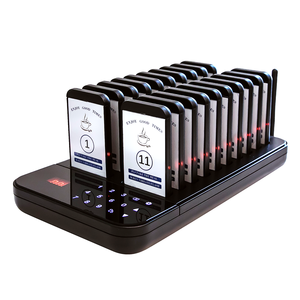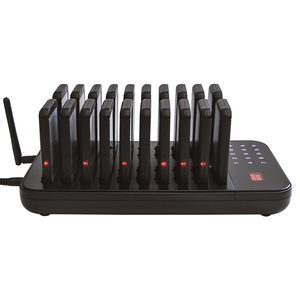(402 products available)































































































































































































A restaurant table ordering system refers to the method that restaurants use to take orders from customers at their tables. The system allows customers to order food and drinks directly from a server or through a digital interface, such as a tablet or smartphone. This system can help improve efficiency, accuracy, and customer experience. The following are some common types of restaurant table ordering systems:
Restaurant table ordering systems are designed to streamline the food ordering process. They have a variety of functions and features that make them efficient and user-friendly. They include the following:
Restaurant table ordering systems are versatile and have several usage scenarios. Here are some of them:
The primary users of table ordering systems are restaurants. The systems are used to help customers place orders and make payments while dining. The table ordering system gives the menu to the customer. The customer can then choose the items they wish to eat from the menu. Some table ordering systems have a feature for making special requests. For instance, a customer can use the system to order food with no onions or no salt. After choosing the food, the customer can then use the system to make a payment. The system will then automatically send the order to the kitchen for preparation. Some table ordering systems also give customers the option to give feedback and rate the service received. This way, managers can know what they are doing right and what they need to improve on.
In casual dining restaurants, people can seat themselves. Here, the table ordering system will have a significant role. Customers can use the system to check the menu and place their order quickly. This makes the dining experience faster and more efficient. Customers can also use the system to split the bill. They can also pay together without having to call the waiter to do it. The system also has a feature for printing receipts, so it is easy for the customers to get their receipt after dining.
The table ordering system is also suitable for cafes and coffee shops. In these instances, it can be used for self-service. Customers can check the menu and order their beverages. The system can also help customers choose the kind of coffee they want. Also, it can offer suggestions on the best coffee to take. The system can also help customers choose the right accompaniments for their coffee and place the order. Customers can also pay through the system, which makes it more convenient for them.
Fast food restaurants can use table ordering systems for self-service kiosks. Customers can use the kiosks to check the menu and place their order. The kiosks are more efficient than having to queue to make an order. Customers can also use the system to pay and then wait for their order to be ready for pick up. The system can also have add-ons to sell more items. For instance, it can suggest a customer buys a soft drink to accompany the burger they have chosen.
Choosing a restaurant table ordering system that integrates with the current POS system is critical for the seamless operation of the restaurant. Integration between the table ordering system and the POS system ensures that orders placed through the table ordering system are automatically transferred to the kitchen for preparation. This helps in reducing errors and improving order accuracy. Integration also allows for real-time inventory management and reporting, which enables restaurant owners to keep track of stock levels and make informed business decisions.
When selecting a restaurant table ordering system, it is important to consider the system's scalability. The system should be able to grow with the restaurant and accommodate increasing demand as the business expands. A scalable table ordering system will enable restaurant owners to add more tables and locations without experiencing any technical limitations. This will help in ensuring that the system can meet the evolving needs of the restaurant and support its long-term growth.
In order to meet specific business requirements, it is crucial to choose a restaurant table ordering system that can be customized. Customization enables restaurant owners to tailor the system to their unique needs and preferences. This includes setting up the menu items, creating user roles, and defining access levels, among others. By customizing the table ordering system, restaurant owners can optimize their operations and provide a personalized experience to their customers.
When selecting a restaurant table ordering system, it is important to choose a system that is easy to use. The system should have a user-friendly interface that is intuitive and requires minimal training. A simple and accessible table ordering system will enable restaurant staff to place orders quickly and efficiently. Additionally, customers will be able to navigate the system without any challenges. This will help in improving customer satisfaction and increasing the adoption of the table ordering system.
Choosing a restaurant table ordering system that is compatible with mobile devices is essential. Mobile compatibility allows restaurant staff to take orders and serve customers from anywhere within the restaurant. Additionally, customers can access the table ordering system using their smartphones or tablets. This provides them with the flexibility to view the menu, place orders, and make payments at their convenience. Ultimately, mobile compatibility enhances the overall dining experience and increases operational efficiency within the restaurant.
When choosing a restaurant table ordering system, it is important to consider the system's reliability and the level of support provided by the vendor. The system should be able to operate without any technical issues or downtime. Additionally, the vendor should offer timely support in case of any problems. This will ensure that the restaurant's operations are not disrupted, and any issues are resolved quickly. As a result, restaurant owners can be confident that the table ordering system will continue to meet their needs and provide a positive return on investment.
Q1: What are the benefits of restaurant table ordering systems?
A1: Restaurant table ordering systems have numerous benefits. They increase the average check value and table turnover rate. They also improve the level of customer service and staff efficiency.
Q2: How do restaurant table ordering systems work?
A2: The systems allow customers to view the menu and place orders from their mobile devices. After ordering, the system sends the request directly to the kitchen. Staff members bring the food and drinks to the table after they are ready.
Q3: What is the best tablet for a restaurant ordering system?
A3: The best tablet for a restaurant ordering system depends on the system's specifications and requirements. However, some of the best tablets are the Samsung Galaxy Tab S7, Apple iPad Air, and the Lenovo Tab M10 HD.
Q4: Do restaurant table ordering systems work offline?
A4: Yes. However, their functionality is limited when they operate offline. When the system is offline, it can only operate in essential parts of the business, such as printing checks and processing payments.